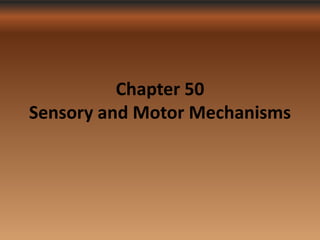
Chapter 50 ppt max chandler ii[1]
- 1. Chapter 50 Sensory and Motor Mechanisms
- 2. Sensory Pathway • Sensory Receptions: Detection of a stimulus by sensory cells or sensory receptors. • The sensory receptors transfer the physical and chemical stimulus to a membrane potential, this process is known as transduction. • Transduction triggers transmission, which is the conversion of membrane potential to action potentials which is then sent to the CNS. • Perception is the final step and it is when the action potential is interpreted by the brain and perceived either as sound, color, smell or taste.
- 3. Fig. 50-2 Sensory Pathway potential (mV) Weak Membrane potential (mV) Action potentials Membrane receptor –50 potential 0 –70 Slight bend: –70 weak 0 1 2 34 5 6 7 Brain perceives stimulus Dendrites Stretch Time (sec) slight bend. receptor 1 2 4 Axon 3 Brain Muscle Brain perceives Action potentials potential (mV) large bend. Membrane Large bend: potential (mV) strong Strong receptor 0 Membrane stimulus potential –50 –70 1 Reception –70 0 1 2 34 5 6 7 Time (sec) 2 Transduction 3 Transmission 4 Perception Types of Receptors: Chemoreceptors, Electromagnetic Receptors, Thermoreceptors, Pain Receptors
- 4. Hearing Through Mechanoreceptors • Humans have a tympanic membrane which is a hair covered membrane in the ear that receives sounds and transmits them to the brain. • Where sound vibrations enter the ear they travel through the cochlear duct and the vibrations are converted to pressure waves. This information is taken to the brain and two things are analyzed from the pressure waves, volume and pitch.
- 5. Fig. 50-8 Middle Outer ear ear Inner ear Skull Stapes Semicircular bone Incus canals Malleus Auditory nerve Cochlear Bone Auditory to brain duct nerve Vestibular canal Tympanic Cochlea canal Oval window Eustachian Pinna Auditory tube canal Tympanic Round Organ of Corti membrane window Tectorial Hair cells membrane Hair cell bundle from a bullfrog; the longest cilia shown are about 8 µm (SEM). Basilar Axons of To auditory membrane sensory neurons nerve
- 6. Taste and Smell • Taste is detected by taste buds on a mammals tongue. • Taste buds have receptors that can read only one taste, when a receptor accepts its respective molecule it attaches it to a protein that then sends it through a pathway to a sensory neuron that interprets the taste of the molecule.
- 7. Fig. 50-15 Taste and Smell Brain Action potentials Olfactory bulb Odorants Nasal cavity Bone Epithelial cell Odorant receptors Chemo- receptor Plasma Cilia membrane Odorants Mucus
- 8. Electromagnetic Reception(Seeing) • Different Types of Eyes – Compound eyes are found in insects and crustaceans and consist of up to several thousand light detectors called ommatidia – Single-lens eyes are found in some jellies, polychaetes, spiders, and many molluscs – Vertebrate Eye; the eye ball, detects color and light, but the brain assembles the information and perceives the image
- 9. Fig. 50-17 2 mm (a) Fly eyes Cornea Crystalline Lens cone Rhabdom Photoreceptor Axons Ommatidium (b) Ommatidia
- 10. Use of Photoreceptors • In vertebrates the eye detects color and light, but the brain assembles the information and perceives the image. • Absorption of light by retinal triggers a signal transduction pathway that hyperpolarizes(increases in polarity) the photoreceptors , causing them to release less neurotransmitters. Synapses transmit information from photoreceptors to the brain. • Rods are light-sensitive but don’t distinguish colors(peripheral vision). • Cones distinguish colors but are not as sensitive to light.
- 11. Fig. 50-18 Sclera Choroid Retina Ciliary body Suspensory Fovea (center ligament of visual field) Cornea Iris Optic nerve Pupil Aqueous humor Lens Central artery and vein of the retina Vitreous humor Optic disk (blind spot)
- 12. Microfilaments and Macrofilaments Underlie our Muscles • Myosin heads (thick muscle filaments) bind to myofibrils (thin muscle filaments) forming cross-bridges. • When the myosin heads are energized by ATP a cycle starts that causes the myosin heads to bend and slide over the myofibrils, this process contracts the muscle. • Cardiac muscle, only within the heart, are electrically connected striated muscle cells.
- 13. Fig. 50-26 Sarcomere 0.5 µm Z M Z Relaxed muscle Contracting muscle Fully contracted muscle Contracted Sarcomere
- 14. Skeletal Systems • Skeletal muscles provide movement by contraction of the muscle pulling against the skeleton. • Types – Hydrostatic Skeleton: Found in most flatworms, nematodes and annelids, consists of fluid under pressure in a closed body compartment. – Exoskeletons: Found in most molluscs and arthropods, are hard coverings deposited on the surface of an animal. – Endoskeletons: Found in sponges, echinoderms, and chordates, are rigid supporting elements embedded with an animal’s body.
- 15. Energy Costs • Animals that specialize in swimming spend less energy per meter traveled than any other type of locomotion for an animal their size.
- 16. Fig. 50-37 RESULTS Flying Running 102 Energy cost (cal/kg•m) 10 1 Swimming 10–1 10–3 1 103 106 Body mass (g)